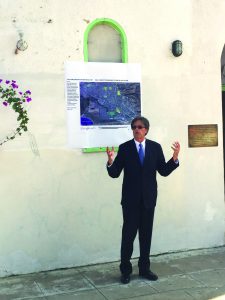Casa Familiar and the California Office of Environmental Health Hazard Assessment (OEHHA), a department of the California Environmental Protection Agency (CalEPA), unveiled the first of 13 air monitors to be deployed in the San Ysidro area.
These monitors are a network of low-cost next generation sensors that will measure when and where air pollution is highest in San Ysidro. This community-led effort is funded by OEHHA as part of an ongoing effort to acquire additional air quality data on the border region.
The data from this network will enhance CalEPA’s community environmental screening tool, named CalEnviroScreen, which will help assess environmental conditions in the area. The Community Steering Committee made up of residents and the research team selected the locations for the monitors.
“For many years, Casa Familiar has been fighting for clean air in our border community of San Ysidro,” said David Flores, Casa Familiar’s Community Development Director. “But we can’t improve air quality if we can’t measure it, and we thank CalEPA for committing resources to help find solutions for air quality for the people of San Ysidro.”
The data collected from the monitors will be directly sent to the University of Washington to be analyzed. The data will be updated every five minutes and is intended to be soon available on a public website.
“One air monitor was installed at the San Ysidro Port of Entry two years ago,” mentioned CalEPA Secretary Matthew Rodriguez, “but the data wasn’t enough to determine the air quality at the border.”
“We decided we needed more information so now there will 13 new air monitors,” said Rodriguez. “We were doing a study about air quality and didn’t had enough information so we focused on getting more data.”
Knowing the quality of the air at the border will let the CalEPA know where it needs to focus its programs, funding, and resources.
“We should really understand where he air quality issues in the state of California are. We know there is likely to be issues here at the border crossing area,” Rodriguez said. “People have talked about air quality related to the trucks idling across the border and there is a lot of traffic in the area but we need to know more to decide what can we do about it and how to improve the air quality.”
The San Diego-Tijuana border is not the region in California that faces air quality issues; there are also places like the 710 Freeway in Los Angeles that has poor air quality.
“From the state level we cannot do it all by ourselves,” said Rodriguez. “We need to reach out to communities so we can work together to face the air quality issues that California faces.”
